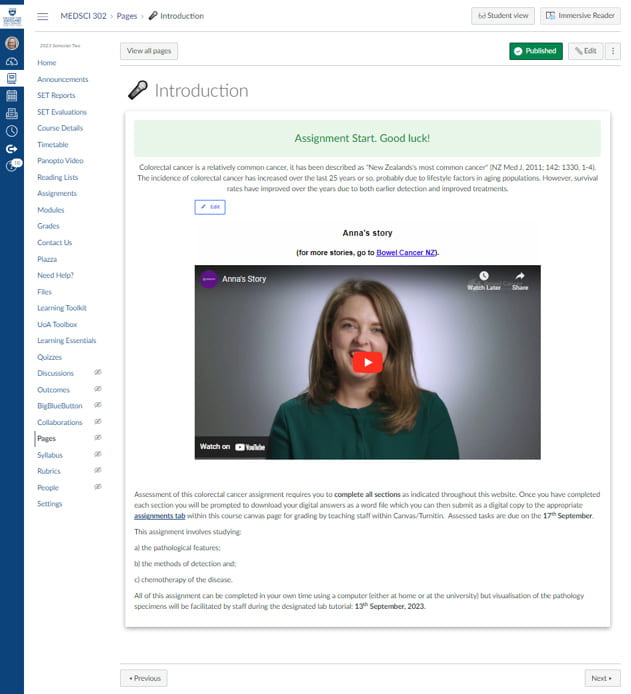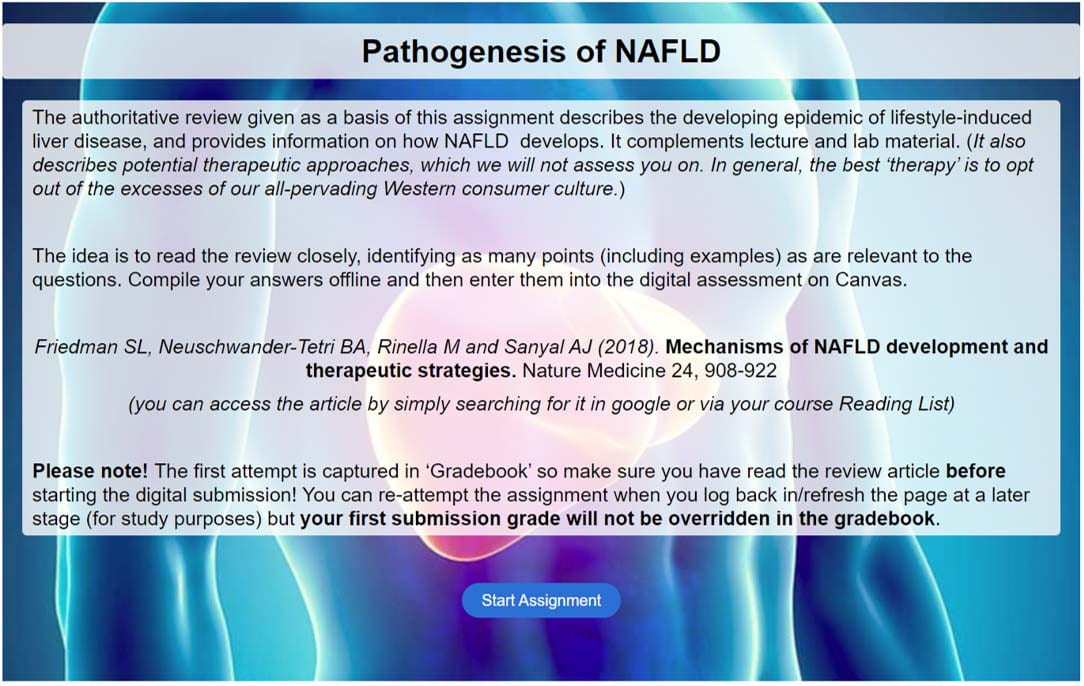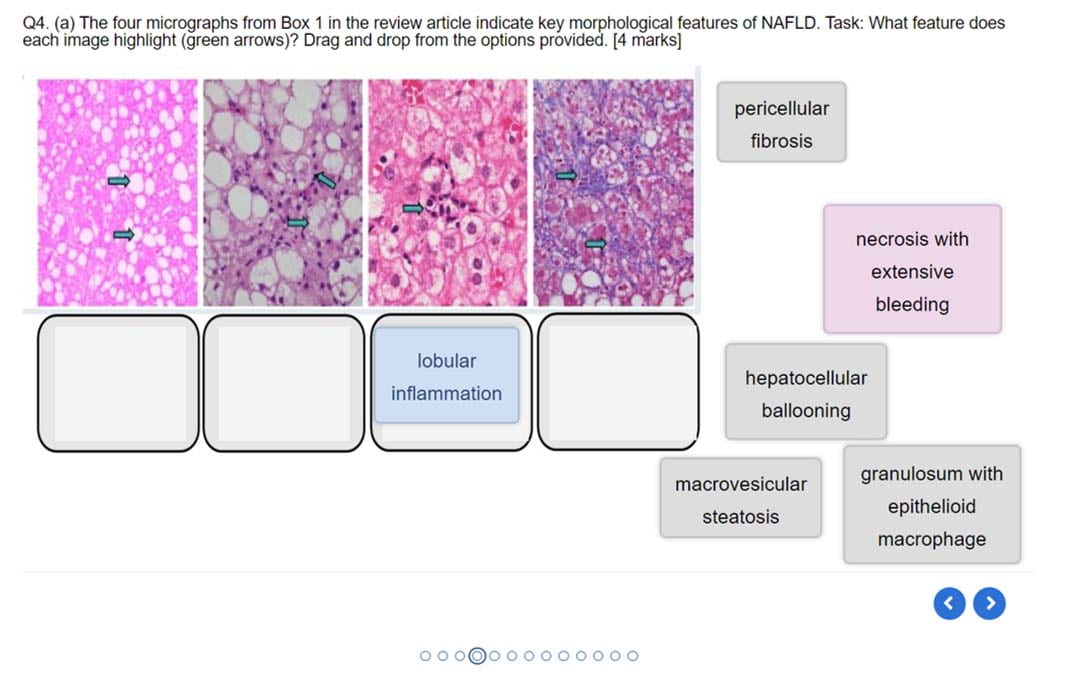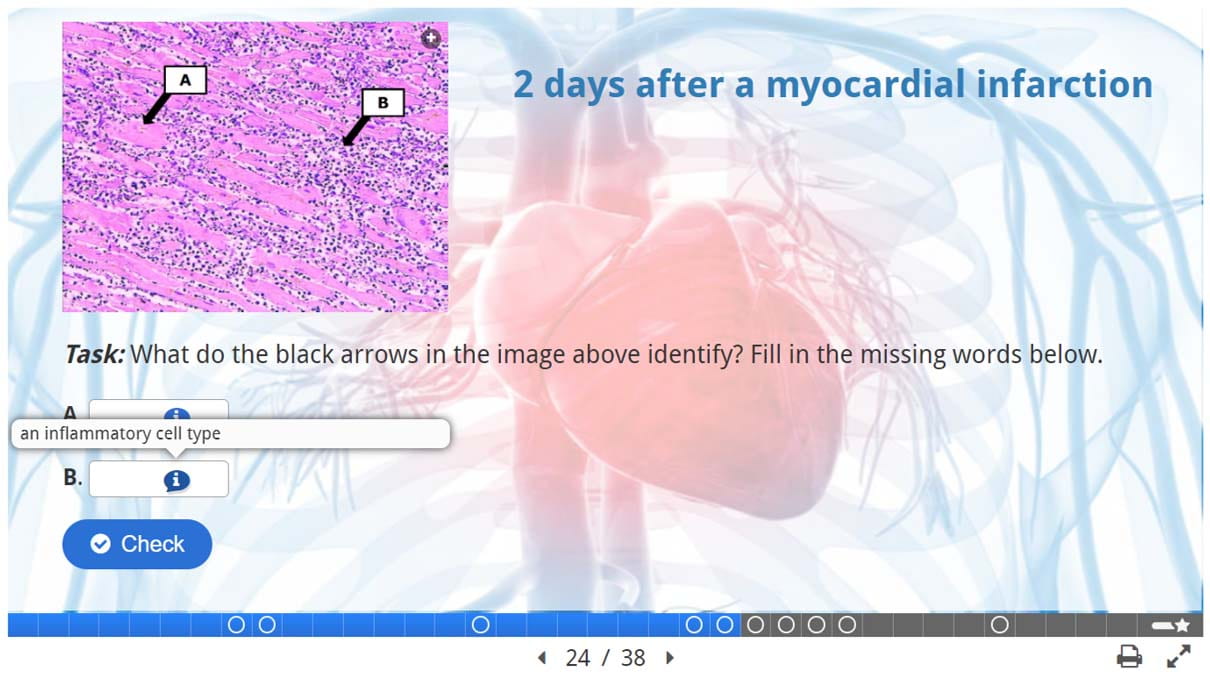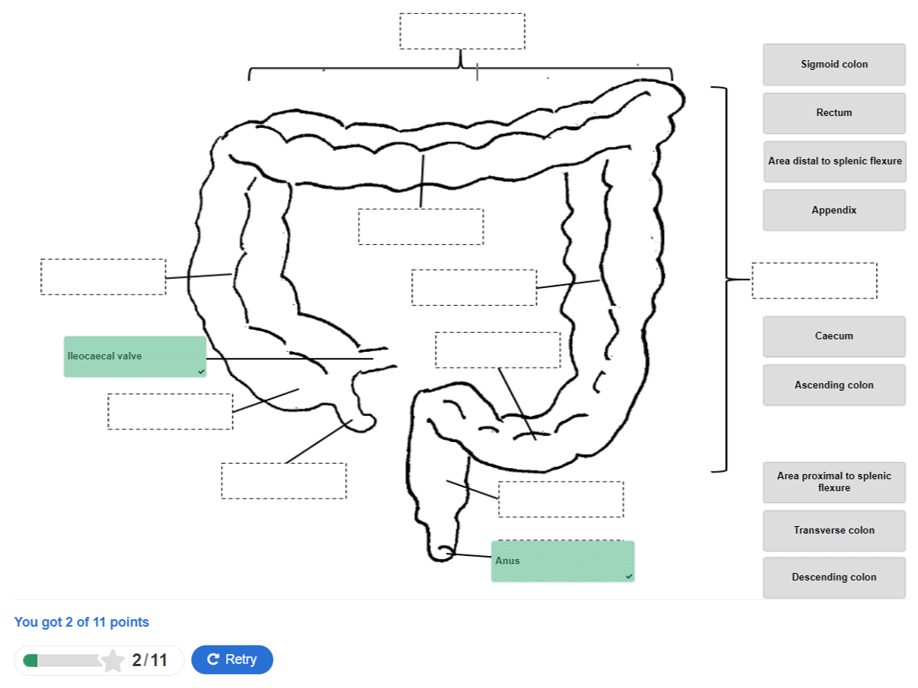Dr Rachelle Singleton from the Faculty of Medical and Health Sciences has leveraged the capabilities of H5P technology to create engaging and interactive learning resources. Her work primarily focuses on Bachelor of Science students pursuing various biomedical science specialisations. Additionally, she aimed to simplify assessment for her colleagues, facilitating a more inclusive and accessible learning experience.

Background
This initiative primarily targeted over 400 undergraduate students across three courses: MEDSCI 203: Mechanisms of Disease, MEDSCI 301: Molecular Basis of Disease, and MEDSCI 302: Cancer Biology. It integrated content into laboratory classes, covering topics such as cell injury and inflammation, while also providing revision modules aligned with lecture content.
Before the shift to online learning due to COVID-19, the diverse student demographics revealed the impact of work, family commitments, and long commutes on their academic performance. To address these diverse needs and the increasing demand for digital technologies, the project aimed to create more engaging and active learning experiences without overburdening teachers. The objective was to provide accessible, formative learning opportunities in hybrid and blended course delivery models, thus making learning more inclusive and overcoming barriers related to distance, time, and individual preferences.
The specific aims were to:
- Develop innovative ways to engage students actively.
- Deliver accessible, formative learning opportunities in hybrid/blended models of course delivery.
- Ensure consistent and timely feedback on practical assessments.
- Expand the capabilities of H5P as a Canvas plugin.
Design challenges and process
The project’s design challenges revolved around creating accessible and engaging blended learning tools and online assessments that wouldn’t add further barriers to student learning. Inclusive approaches required diverse methods that catered to different student talents, offered choices in assessments, and ensured consistent and timely feedback. A significant aspect of the project was involving students in the design process to ensure that assessment briefs and feedback/feedforward were user-friendly. The project team used feedback from student evaluations and had graduate students from various disciplines test and refine the online content on different digital devices before its release to enrolled students.
Figure 1. Example of a MEDSCI 302 online colorectal cancer module (Canvas page with embedded H5P interactions).
The resources developed in this project included:
- Replacing traditional written assessments with various interactive digital activities.
- Creating new online modules with interactive, formative activities to complement lecture material.
- Designing critical review article assignments integrated with the Canvas gradebook.
- Crafting quiz questions in multiple formats.
- Providing a hard-copy lab manual with digital quiz questions for offline preparation.
- Designing a digital learning resource with interactive slides for autonomous use during practical labs.
- Developing a large Canvas module linking lecture concepts to real-world case studies with numerous ungraded/formative H5P activities.
- Using H5P as a Canvas plugin to monitor student interactions and track progress.
- Pre- and post-lab quizzes featuring rich histology content.
This ‘flipped classroom’ approach allowed for accessible, formative learning opportunities beyond traditional face-to-face classes, optimising in-person class time for observing physical pathology specimens.
Implementation and evaluation
Reflecting on the project, Rachelle highlighted the valuable support received, including a 0.2 FTE (full-time-employee) time release and a SEED fund grant for innovation in teaching in 2019. This greatly facilitated the implementation of H5P content within her courses, boosting student engagement, learner participation, and excitement about the taught content.
The seamless integration of H5P activities with Canvas gradebook led to automatic, comprehensive feedback and enhanced tracking of student engagement and achievement. These activities reduced the burden of grading during peak times, offering flexibility in teaching and improved accessibility for students, addressing barriers related to distance, time, and preference. The project’s insights and content proved exceptionally beneficial during the rapid shift to online teaching prompted by the pandemic.
What worked well?
The project’s benefits included:
- positive student feedback
- timely, useful feedback and fair grading
- enhanced student engagement
- improved tracking and analytics for teaching
- reduced marking workload
What would be done differently?
‘Lessons learned’ included the following:
- A more holistic approach to course assessments, with a focus on building assessments that interconnect and incorporate student self-reflection.
- Emphasising H5P’s detailed student reports for tracking engagement and enhancing teaching strategies.
- Collaborative efforts within teaching teams to empower all staff to create online learning resources.
- Testing content with graduate teaching assistants and ensuring compatibility across various devices.
- Providing clear instructions to students for online activities, including their value, weighting, format, and relevance.
Continued impact and growth
Last year, Rachelle’s team introduced a site-wide license for H5P, making it easily accessible across the University. Since then, Rachelle and the University-wide Community of Interest (CoI) for H5P users have been providing invaluable support through hands-on workshops, empowering staff to create engaging content for active learning.
Impressive growth
The impact has been significant! From less than 100 staff authors at the close of 2021, there were over 400 staff authors and 11,000 learners benefiting from H5P in Semester One of 2022.
Research project and international recognition
Rachelle spearheaded a research project evaluating the effectiveness of H5P and faculty development workshops. This involved analysing a diverse set of data, including surveys, interviews, workshop exit surveys, and student evaluations. The findings were presented internationally1 2 and are now published in a peer-reviewed journal.3
Recognition and awards
Rachelle’s leadership in building staff capability for online teaching with H5P earned her the Faculty of Medical and Health Sciences Butland Leadership in Teaching Award in 2022. Additionally, the CoI of H5P users received a ‘Highly Commended’ award from The Australasian Council on Open, Distance, and e-Learning (ACODE) Technology Enhanced Learning (TEL) in 2022. You can watch the nomination video on YouTube.
Project resources
You can listen to Rachelle’s 2019 presentation, ‘A new canvas for teaching and learning with H5P’ at the FMHS Teaching and Learning Community. Also listen to workshop recordings with examples of H5P learning activities and how they integrate with Canvas.
- H5P Interactive Books
- H5P Live Polling
- H5P Course Presentations
- H5P Student Drill-down Reports (student analytics)
- Presentation at UoA Learning Design Community of Interest, ‘Use of H5P to support active learning‘
- Singleton, Rachelle. “A New Canvas for Teaching and Learning with H5P.” Presentation at HERDSA Annual Conference, Brisbane, Australia, July 2021. https://conference.herdsa.org.au/2021/program/. ↩
- Clune, Megan., Amanda Charlton, Monica Kam, Tanisha Jowsey, Daniela Ruiz Cosignani, and Rachelle Singleton. “Strengthening Online Teaching Capability: Medical and Health Sciences Faculty Development. (Pecha Kucha Presentation)” In 39th International Conference on Innovation, Practice and Research in the Use of Educational Technologies in Tertiary Education, edited by Stephanie Wilson, Natasha Arthars, Dewa Wardak, Pippa Yeoman, Eszter Kalman, and Danny Y.T. Liu, 4-7. Sydney, Australia: ASCILITE, 2022. https://doi.org/10.14742/apubs.2022.29. ↩
- Singleton Rachelle S., Daniela Ruiz Cosignani, Monica Kam, Megan Clune, Amanda Charlton, and Tanisha Jowsey. “Faculty Development for Strengthening Online Teaching Capability: A Mixed-Methods Study of What Staff Want, Evaluated With Kirkpatrick’s Model of Teaching Effectiveness (Version 1; Peer Review: 1 Approved).” MedEdPublish, No. 13:127 (2023). https://doi.org/10.12688/mep.19692.1. ↩

